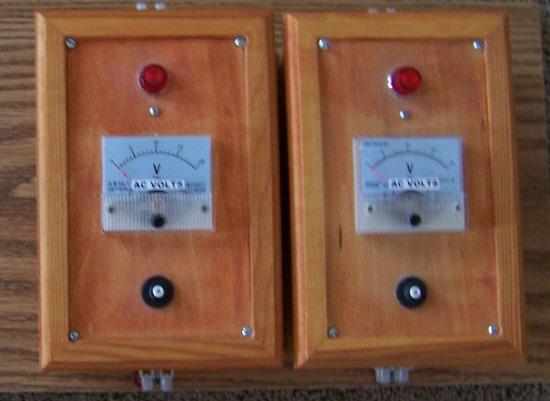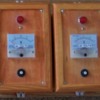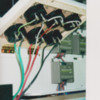Can anyone point me in the direction of low cost volt amp and watt meters. I want to incorporate them into my control panel. Analog or digital is fine.
Replies sorted oldest to newest
Contact U Do It Electronics in Needham, Mass. That is where I buy my equipment. High quality with a decent price. It is a smart move to buy good equipment and switches and do the job ONE time. Stay clear of RS switches. Do not cheap out on these electrical items.
Watt meters are relatively uncommon, especially for low voltages. I don't know of anyone who has wattmeters installed on their control panels.
If you want to measure line-voltage watts, the Kill-A-Watt unit, which is sold at Harbor Freight and other places for about $30, is a very comprehensive unit - volts, amps, watts, vars, power factor, frequency, watt hours, time. I use one at home and another in my RV for checking outlets in RV parks. It can tell you what is going into your train transformer, but not what is coming out. (Also great for energy conservation testing of your home appliances!)
Panel mount meters of good quality are really expensive like a couple hundred each. I bought some on the bay for $140 for 6 volt and 6 amp meters
LightObject has a good selection of affordable analog volt and amp meters.
I don't think you need to spend a ton of money on metering for the typical model train layout. The precise measurements are not all that important. I guess I'm not seeing a reason to spend hundreds of dollars trying to measure precisely the amount of voltage and current you're using. 5% accuracy would probably be quite sufficient.
Thats how I figured it john. I just need to know with a "close enough kind of attitude" what my voltage and current draw are. Taking voltage at the output of the TIU and current at the input of the TIU.
Glenn Hammons posted:Can anyone point me in the direction of low cost volt amp and watt meters. I want to incorporate them into my control panel. Analog or digital is fine.
Am curious why you ask about watt meters? To be clear, I believe there are many benefits to a watt (power or scale Horsepower) indication but as others point out, this is not common practice and I don't think you will find any that are "low cost". It is technically difficult to accurately (within, say, 10%) measure Watts in a model train layout; there have been a few threads on OGR that get into the technical nitty-gritty if you care to dig deeper.
Thanks for the input guys. I found the meters I was looking for at a very low cost. I am in the process of building my first layout; a 6x12 Lionel fastrak railroad and am learning the electronics of it all. Since Lionel transformers are rated in Watts I thought it would be interesting to measure the total load on the layout with a Wattmeter.
Right now I have set up for V/A meters on18V track power, and another set for 12V accessory power since those are my two preset posts on the GW-180 transformer. It would seem there are more voltages needed like 14V for switches or the variety of differing electrical needs for Lionel accessories. Planning on running switches on 12V as I read someone in the forum who studied that out, and noted there was no noticeable change in fastrak switch performance above I believe 10V.
I have no clue yet as to what accessories will lead to electrically. The focal points will be a Lionel Rocket Launcher, Hanks Ford. Harrys Barber Shop, UFO Cafe, the Lionel Hobby Store and one of the Diners.
Everyday on the railroads an electrical adventure!
Since you are interested in "total load on the layout" and you have multiple voltages in play, it would get spendy to individually instrument the multiple outputs with true Watt-meters and adding numbers to get "total load." To that end I like Dale's suggestion about a Kill-A-Watt - albeit measuring the 120V side and not particularly conducive to mounting on a control panel. $28 at Harbor Freight less 20% off coupon from Sunday paper and it's about $23. Or, check your local library; at mine you can borrow a Kill-A-Watt like borrowing a book!
Attachments
How about posting what meters you purchased? Always interested in what other folks find out there and it may help others as well. Pictures are most welcome too.
I should have the meters this week, and will mount them next weekend. Will post a picture of them in the control panel along with the make, model and source once they are installed.
I use separate volt and amp meters on my HO layout. For that purpose I prefer analog. I don't need exact measurements, just a convenient indication of power loss or short circuit. I've sometimes used analog meters on O-gauge layouts but the readings tend to jump all over because the old universal motors typically generate voltage spikes.
Thanks, I will be watching for your pictures and meter info. Good luck with your panel.
Volts times Amps = Watts
The accessory output on the GW-180 is adjustable. It is factory set at 12Vac. See pages 11 & 12 of the manual.
You may want a couple of small transformers to tune the voltage to the accessories for the best operation.
ChooChoo Bob posted:Volts times Amps = Watts
Well... under certain circumstances for AC power. ![]() That's only true at a power factor of 1.0.
That's only true at a power factor of 1.0.
Here is my in-progress control panel, and a close up of the V/A meters. You can find the meters at www.lightobject.com (Thanks Gilly!) by searching on "Electronics" and then "Analog Meters" They list about 20 different gauges that are under $10.00, and seem to be well manufactured for the price.
Attachments
gunrunnerjohn posted:ChooChoo Bob posted:Volts times Amps = Watts
Well... under certain circumstances for AC power.
That's only true at a power factor of 1.0.
And if the voltage and current waveforms are both sinusoidal, which they seldom are these days. ![]()
Another good point. ![]()
That complicates the measurement even more as the voltage and amperage reading are seldom all that accurate.
As I reflect upon power (Watt) measurement, manufacturers don't specify power requirements of their products. Hence what's the point of measuring it?! There have been ad hoc tables of typical power consumption of an engine, a lighted passenger car, a motorized accessory, etc., but these seem to come from end-users. To wit, I don't recall (someone correct me) ever seeing an engine review where power was measured such as Watts on idle, Watts @20 sMPH unloaded, up a 2% grade pulling 5 cars with smoke on, whatever.
Plus, in O-gauge, I see zero interest in "scale" modeling of power for prototypical operation. I suspect the O-gauge model of, say, the state-of-the-art GEVO engine draws the same electrical power as a similar puller from the last century....in fact it might require more power with all those LEDs flashing! ![]()
stan2004 posted:As I reflect upon power (Watt) measurement, manufacturers don't specify power requirements of their products. Hence what's the point of measuring it?! There have been ad hoc tables of typical power consumption of an engine, a lighted passenger car, a motorized accessory, etc., but these seem to come from end-users. To wit, I don't recall (someone correct me) ever seeing an engine review where power was measured such as Watts on idle, Watts @20 sMPH unloaded, up a 2% grade pulling 5 cars with smoke on, whatever.
Plus, in O-gauge, I see zero interest in "scale" modeling of power for prototypical operation. I suspect the O-gauge model of, say, the state-of-the-art GEVO engine draws the same electrical power as a similar puller from the last century....in fact it might require more power with all those LEDs flashing!
I agree completely.
Assuming that the intent is to "protect" electrical equipment, like wires, transformer windings, semiconductors, etc., from overheating, it is all about amperes, not watts. I think that wattage ratings on small equipment are a hold-over from some long-ago (or perhaps current!) UL requirement from the pre-electronic era. Indeed, "real" electrical equipment is rated in kVA, not watts.
As far as prototypical purposes, I suspect that the actual useful power consumption of most model railroad items is dominated by losses, electrical, mechanical or otherwise. Definitely true of the universal motor stuff, the PM motors are better but then you have the electronic losses in the rectifiers and controls.
Of course, the performance of steam locomotives was all losses too!
Glenn Hammons posted:Here is my in-progress control panel, and a close up of the V/A meters. You can find the meters at www.lightobject.com (Thanks Gilly!) by searching on "Electronics" and then "Analog Meters" They list about 20 different gauges that are under $10.00, and seem to be well manufactured for the price.
Glenn,
Wondering how this worked out for you and how you wired the gauges up. Looks like a fun project to me. Do I need it??? No do I want it?? Yes. ![]()
Wattage = Voltage (in Volts) x Amperage (in amps) . If you measure both you have the wattage draw. On my layout the yardstick is amperage draw.
FYI, there is a big difference in the rated wattage that a transformers input is as opposed to what it provides at its output.. A ZW is rated for 275 watts input but the device is not 100% efficient. You will probably get around 160 watts output.
Watts only equal amps times volts in a perfect world. If the power factor is not 1.0, or the waveform is not a pure sine wave, that's not usually the case. ![]()
Inexpensive analog meters are not near precise but over time I have found them to be satisfactory for indicating the power and the load range on a toy train layout. Back in the very early days of the Forum I imported meters through a New Zealand Electronics Company and sold them at cost to Forumites who were constantly asking about meters. The meters were assembled in Japan of Taiwanese parts and claimed a 2-3 % variation in accuracy. Anyway I sold several hundred units before all the air freight in the supply chain, plus my U.S. packing and shipping cost drove the total cost above $10 per meter . However I stayed with it for a few years until I received a query from the nosy  N.C. Dept of Revenue at which time I bailed
N.C. Dept of Revenue at which time I bailed . Anyway Light Object came along in a few years with good enough analog meters for $9-10.
. Anyway Light Object came along in a few years with good enough analog meters for $9-10.
For my use I preferred meters of 0-25 VAC range and 0-15 AAC range to enable a decent scale for reading . The attached photo shows a bank of meters for my 1992 built, airborne, twin shelf, 14x32, 5 track operation at our mountain cottage in western N.C. (layout demolished in 2008). The power districts were fused to protect the five channels of 3 pw ZWs being used as power at the time. I later replaced with five 180 Powerhouses and eliminated the fuses.
Attachments
KRM
The photo below shows the backside of a 3-meter panel. Top row contains 3-volt meters, the bottom 3-amp meters.
White wire is common, colored/black wires are hot and represent the 3 power districts. Note that the amp meters are wired inline on the colored and black hot wires and the volt meters are wired across-the-line between the hot and common wires. The short jumpers from one post of the amp meters up to a post of the volt meters is simply a way to energize the volt meters.
Conductors to and from the amp meters must be sized to carry the entire load of its power district. Conductors for the volt meters can be smaller wires.












